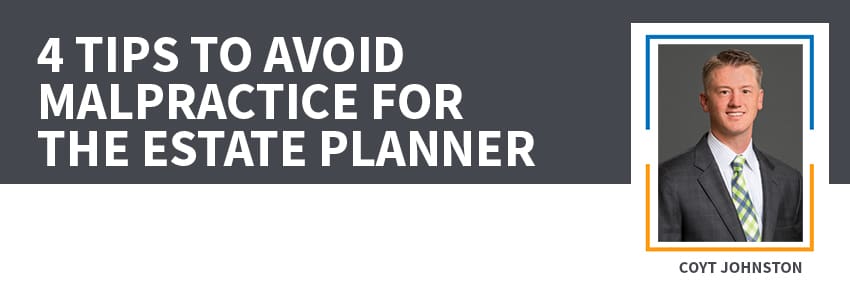 Estate Planning should documented down to the last detail. With these simple steps below, you can help prevent a future case for malpractice.
Estate Planning should documented down to the last detail. With these simple steps below, you can help prevent a future case for malpractice.
-
Make sure the scope of the representation is clean, clear, and correct.
All too often lawyers are less than precise with the language used to define the scope of the representation. Many times this is because the entire scope of what you are being asked to do is not very well defined at the beginning. But that is no excuse for sloppy language in defining the scope of the representation. Sloppy language creates ambiguity, and ambiguity is never a good thing in an engagement contract. For one, the ambiguities will be construed against the lawyer and in favor of the client. But also, no one wants to get sued, after the fact, for tasks they did not even think they were handling. The best practice is to communicate clearly and early on about precisely what tasks you are undertaking and responsible for.
-
Diagram the plan and memorialize your whiteboard.
Diagramming the estate plans is a great way to visualize to everyone how the plan will operate upon the death of your client. It is important to be detailed and walk your clients through the plan. At the end of your meeting with the clients, write the date and name of the clients on the board, and then take a picture of it for your file. This picture will be a very important exhibit if a beneficiary down the road says “Mom would never want…” The whiteboard will show exactly what was discussed with Mom and what she wanted.
-
Make sure it is clear who you are and are not representing
Estate planners are often hired by married couples and many times requires communication with/for future beneficiaries. This can create confusion about who the client is and more importantly, who it is not. This confusion is problematic for a couple of reasons. Firstly, under Texas law, a lawyer can be sued by a non-client in situations where a client thinks they are being represented, the reasonable person would have thought the lawyer was representing them and the lawyer did not expressly tell them that they were not representing them. Secondly, in the estate planning world, it is not uncommon that the interests and wishes of the client will conflict with those of the client’s beneficiaries. And if that happens you do not want to be disqualified from the continued representation of your client.
-
Outline future events that might require revisiting the plan
Make sure you explain, in writing, that estate plans often need to be revisited as your estate and your life becomes more complicated. Certainly, things like births, deaths, and divorces change the needs and complexity of an estate plan, but so does life. Presumably, the longer one lives the more opportunity and time they have to amass wealth, which will also presumably require a more complicated estate plan. Explaining that the estate plan may require future adjustment, both encourages clients to come back to you, but more importantly, prevents you from being blamed if the estate plan becomes stale and outdated.
By incorporating these 4 tips into your estate planning client sessions, you’ll be better prepared to defend the decisions made during the outlining process, thus avoiding malpractice.
